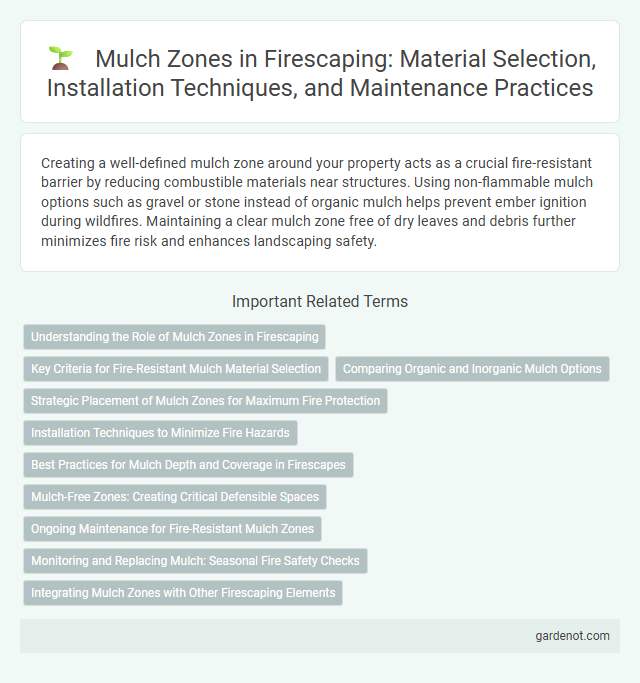Creating a well-defined mulch zone around your property acts as a crucial fire-resistant barrier by reducing combustible materials near structures. Using non-flammable mulch options such as gravel or stone instead of organic mulch helps prevent ember ignition during wildfires. Maintaining a clear mulch zone free of dry leaves and debris further minimizes fire risk and enhances landscaping safety.
Understanding the Role of Mulch Zones in Firescaping
Mulch zones play a critical role in firescaping by acting as a buffer that reduces fire risk around structures through moisture retention and the suppression of dry, flammable debris. Proper selection of non-combustible or fire-resistant mulch materials, such as gravel or decomposed granite, enhances fire resistance compared to organic mulches. Strategic placement of mulch zones combined with regular maintenance prevents accumulation of dry vegetation, effectively minimizing the potential for wildfire ignition and spread near homes.
Key Criteria for Fire-Resistant Mulch Material Selection
Selecting fire-resistant mulch for a mulch zone requires prioritizing materials with low combustibility, such as gravel, stone, or inorganic rubber mulch. Key criteria include moisture retention capacity, minimal flammability, and the ability to create a barrier that slows fire spread. Avoiding highly combustible organic mulches like bark or shredded wood reduces wildfire risk and enhances the safety of the fire-resistant landscape.
Comparing Organic and Inorganic Mulch Options
Organic mulch options such as wood chips, bark, and straw improve soil fertility and moisture retention, enhancing plant health in the fire-resistant mulch zone. Inorganic mulches like gravel and basalt rock offer longer durability and increased fire resistance but do not contribute to soil nutrients. Selecting mulch for firescaping depends on balancing fire safety requirements with soil enrichment and maintenance preferences.
Strategic Placement of Mulch Zones for Maximum Fire Protection
Strategic placement of mulch zones enhances fire protection by creating defensible spaces that slow wildfire spread and reduce fuel availability near structures. Using non-flammable mulch materials such as gravel or decomposed granite around buildings minimizes ignition risks and maintains soil moisture, which inhibits fire intensity. Properly designed mulch zones combined with appropriate plant selection can significantly improve landscape resilience against wildfires.
Installation Techniques to Minimize Fire Hazards
Mulch installation techniques to minimize fire hazards include maintaining a minimum 3-foot clearance around structures and choosing non-flammable mulch materials such as gravel or stone. Proper layering avoids thick, continuous mulch beds that can ignite easily, while regular moisture retention through irrigation reduces the risk of fire spread. Strategic placement of mulch beneath fire-resistant plants further enhances the safety of the mulch zone in firescaping design.
Best Practices for Mulch Depth and Coverage in Firescapes
Maintaining a mulch depth of 2 to 3 inches in firescaping reduces ignition risk while preserving soil moisture and promoting plant health. Using non-woody, non-flammable mulch materials such as compost or gravel minimizes fire spread and enhances safety near structures. Consistent coverage without gaps or excessive layering prevents fuel buildup, ensuring effective fire-resistant landscape zones.
Mulch-Free Zones: Creating Critical Defensible Spaces
Mulch-free zones play a crucial role in firescaping by creating critical defensible spaces around structures to reduce fire risk. Maintaining a clear area, typically 3 to 5 feet wide, free of combustible mulch prevents fire spread and allows firefighters better access. Implementing mulch-free zones with non-flammable materials like gravel or bare soil enhances home protection during wildfires.
Ongoing Maintenance for Fire-Resistant Mulch Zones
Regular inspection and replenishment of fire-resistant mulch in the mulch zone are critical to maintaining its effectiveness in wildfire prevention. Removing debris, such as fallen leaves and twigs, minimizes fuel buildup that could ignite easily. Proper moisture retention and avoiding combustible materials ensure the mulch continues to act as a protective barrier around the property.
Monitoring and Replacing Mulch: Seasonal Fire Safety Checks
Regular monitoring of the mulch zone is essential for fire safety, as decomposing mulch can accumulate dry, flammable material that increases fire risk. Seasonal inspections should identify areas where mulch has thinned or compacted, making it necessary to replenish with fire-resistant materials such as shredded hardwood or inorganic options. Replacing mulch in the fire-safe zone helps maintain proper moisture levels and minimizes combustible debris, reducing the likelihood of wildfire ignition near structures.
Integrating Mulch Zones with Other Firescaping Elements
Integrating mulch zones with other firescaping elements enhances wildfire resistance by creating strategically designed barriers that reduce fuel continuity around structures. Combining mulch with fire-resistant plants, gravel pathways, and hardscape features establishes defensible spaces that slow fire spread and increase homeowner protection. Properly planned mulch zones complement irrigation systems and firebreaks to maintain moisture levels and reduce ignition risks.
Mulch zone Infographic

 gardenot.com
gardenot.com